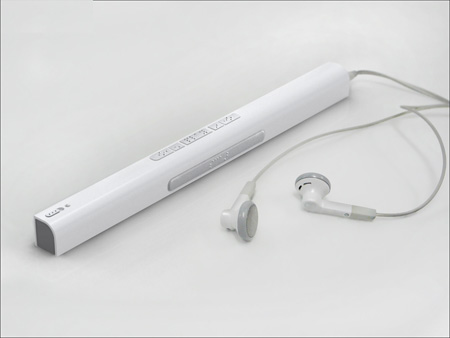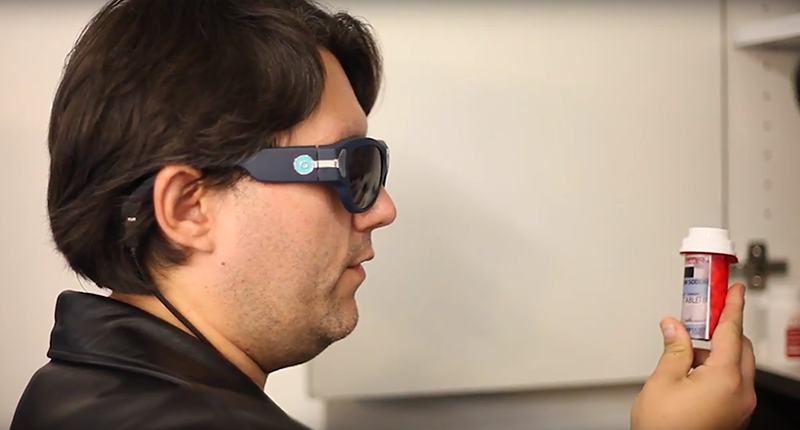Discover Ingenious Devices Developed for the Aesthetically Impaired
The growth of innovative devices for the aesthetically impaired stands for a considerable advancement in availability and independence. Technologies such as wise glasses with AI capabilities and mobile applications made to offer auditory summaries are improving daily experiences for customers. Additionally, wearable gadgets that use haptic feedback improve ecological awareness, while contemporary Braille technologies provide brand-new means to engage with text. As these devices remain to evolve, their effect on the lives of those with aesthetic impairments raises crucial inquiries about the future of inclusivity and autonomy in numerous aspects of life. What lies in advance in this technical landscape?
Smart Glasses for Navigating

Smart glasses created for navigation are transforming the means aesthetically damaged people interact with their environment. These advanced tools make use of a mix of video camera innovation, expert system, and acoustic comments to provide real-time details regarding environments. By utilizing obstacle discovery systems, wise glasses can alert customers to potential threats, allowing safer flexibility in both familiar and strange settings.
The assimilation of GPS innovation further boosts navigation capacities, allowing customers to receive acoustic directions as they relocate. This hands-free approach not just cultivates freedom however also equips aesthetically impaired people to navigate city landscapes with enhanced self-confidence. Additionally, lots of smart glasses are furnished with features that determine spots and street indications, giving contextual information that improves the customer experience.
Furthermore, the growth of these devices is continuously progressing, with companies working to enhance the precision of object recognition and broaden the series of navigational features. As wise glasses come to be more available and affordable, they hold the potential to considerably change every day life for aesthetically damaged users. Eventually, these ingenious devices stand for an essential step toward inclusivity, offering enhanced movement and a higher feeling of autonomy for individuals navigating the world around them.

Mobile Apps for Daily Living
Exactly how can mobile applications enhance the lives of aesthetically damaged individuals? Mobile apps are changing the method visually damaged individuals browse their environments, manage everyday jobs, and gain access to information. These applications supply necessary support via various capabilities, promoting independence and boosting lifestyle.
Several cutting-edge mobile apps are designed especially for everyday living. As an example, apps like Be My Eyes attach visually damaged users with sighted volunteers using video clip calls, permitting them to get real-time aid with jobs such as checking out tags or navigating strange areas. Seeing AI, established by Microsoft, utilizes fabricated intelligence to describe surroundings, read text, and identify items, properly transforming a mobile phone right into an effective tool for daily support.
Furthermore, navigating applications tailored for the visually impaired, such as Aira and BlindSquare, use audio-based instructions and ecological details, making it possible for customers to traverse their surroundings securely and with confidence. Past navigating and immediate support, mobile applications additionally sustain company and job management, with attributes that aid users set pointers, produce order of business, and track consultations. In recap, mobile applications offer as vital sources, equipping aesthetically impaired people to lead even more independent and fulfilling lives.
Wearable Technologies for Support
Empowerment via modern technology is increasingly apparent in the world of wearable gadgets created to aid visually impaired people. These innovative tools incorporate seamlessly right into day-to-day live, boosting navigating and giving essential feedback to individuals. Clever glasses outfitted with electronic cameras can recognize faces and check out text out loud, permitting individuals to communicate more with confidence in social and professional settings.
One more significant development is the usage of haptic comments systems in wearable devices. These systems use resonances or other tactile signals to convey details regarding the user's setting, such as challenges or changes in surface, improving wheelchair and safety. Wearable modern technologies likewise include wristbands that attach to mobile phones, alerting individuals to notices via subtle vibrations, therefore boosting connectivity without dependence on visual signs.
As these innovations remain to progress, they are not only enhancing independence for aesthetically damaged individuals yet likewise promoting a greater feeling of inclusion in society. By linking the space in between challenges dealt with in daily living and the capacity for freedom, wearable technologies work as pivotal devices in the pursuit for equality and empowerment for those with aesthetic problems.
Audio Summary Devices
Audio description tools play a vital function in boosting accessibility for visually damaged people, offering them with the capability to engage with visual media. Screen readers for the blind. These devices supply narrated summaries of vital visual elements in films, tv programs, and live efficiencies, guaranteeing that users can totally understand the context and emotions communicated via visuals
Sound description can be incorporated into different systems, consisting Smart glasses for the visually impaired of streaming solutions, movie theater screenings, and live theater. Numerous prominent streaming solutions currently consist of audio summary as an accessibility feature, allowing audiences to choose it quickly. Along with conventional media, specialized applications additionally exist, giving audio summaries for art events, galleries, and various other social occasions.
The performance of audio summary rests on the ability of the storytellers, that need to communicate visual details succinctly without diminishing the original sound. Innovations in this area are likewise leading the way for more tailored experiences, where customers can readjust the degree of detail and pacing according to their preferences.
Braille Innovations and Tools
Braille developments and devices have actually significantly transformed the way visually impaired individuals engage with message and info. Modern developments have led to the advancement of functional devices that boost proficiency and freedom amongst customers.
Moreover, mobile Braille notetakers incorporate traditional Braille input with modern-day capabilities, helping with note-taking, organizing, and document editing on the move. Braille displays and notetakers. These small devices frequently feature text-to-speech capabilities, bridging the void in between Braille and acoustic info
Additionally, innovative Braille printers have actually arised, enabling individuals to produce Braille labels, documents, and academic materials effectively. This accessibility promotes better participation in educational and specialist environments, inevitably promoting inclusivity.
Additionally, study right into wise Braille technologies remains to broaden. Devices that include expert system are being discovered to supply real-time navigation aid and contextual info, enhancing the customer experience in diverse setups. Generally, these advancements mirror a commitment to empowering aesthetically impaired people via modern technology, guaranteeing they can easily access and engage with the world around them.

Final Thought
The development of innovative devices for the visually damaged substantially enhances freedom and lifestyle. Smart glasses, mobile applications, wearable technologies, audio description tools, and Braille technologies collectively equip people by offering crucial navigation help, ecological recognition, and enhanced analysis experiences. These modern technologies not just foster better incorporation yet also promote autonomy in daily activities, ultimately contributing to a more available and equitable society for visually impaired people. Proceeded growth in this area holds assurance for more improvements.
As wise glasses become more affordable and obtainable, they hold the prospective to considerably transform daily life for visually damaged individuals. Mobile applications are reinventing the way aesthetically impaired customers navigate their atmospheres, handle everyday tasks, and gain access to details. Apps like Be My Eyes link aesthetically impaired users with sighted volunteers through video clip calls, enabling them to obtain real-time assistance with tasks such as reviewing labels or navigating unfamiliar spaces.Additionally, navigation apps tailored for the aesthetically impaired, such as Aira and BlindSquare, use audio-based directions and ecological information, enabling customers to traverse their environments securely and with confidence.The innovation of ingenious tools for the aesthetically damaged significantly improves independence and high quality of life.